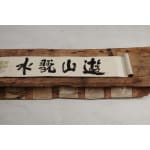Ike no Taiga (1723–1776)
Rambling among Hills and Streams
Color on paper, handscroll
Titled by the artist
Inscribed with 2 Chinese-style poems by the artist
Dated Meiwa 2 (1765)
Titled and box authentication by Yamanaka Rankei (1966)
Seals: Taiga; Ike Mumei in; Sude ni senri no michi wo yukedomo imada bankan no sho wo yomazu;
Junsei; Gyokko Koan ri; Hanchi Hankatsu Sensei
28 x 627.4 cm
29.4 x 758.4 cm (overall)
Titled by the artist
Inscribed with 2 Chinese-style poems by the artist
Dated Meiwa 2 (1765)
Titled and box authentication by Yamanaka Rankei (1966)
Seals: Taiga; Ike Mumei in; Sude ni senri no michi wo yukedomo imada bankan no sho wo yomazu;
Junsei; Gyokko Koan ri; Hanchi Hankatsu Sensei
28 x 627.4 cm
29.4 x 758.4 cm (overall)
Further images
-
(View a larger image of thumbnail 1
)

-
(View a larger image of thumbnail 2
)

-
(View a larger image of thumbnail 3
)

-
(View a larger image of thumbnail 4
)

-
(View a larger image of thumbnail 5
)

-
(View a larger image of thumbnail 6
)

-
(View a larger image of thumbnail 7
)

-
(View a larger image of thumbnail 8
)

-
(View a larger image of thumbnail 9
)

-
(View a larger image of thumbnail 10
)

-
(View a larger image of thumbnail 11
)

Provenance
Collection of Sakata TaijiLiterature
Kokka no. 646. Tokyo: Kokkasha, 1944.The Works of Ike-no Taiga. Tokyo: Chuo-koron Bijutsu Shuppan, 1960.
Ike no Taiga handwrote the title of this work, Playing in the Mountain, Enjoying the Water, at the beginning of the handscroll, painted the image, and composed the poems at the end. The painting itself begins with a waterscape and mounded banks of willow trees. Taiga perhaps was imaging West Lake. The composition starting with a distant view in the upper right closely resembles Taiga’s Spring Dawn on the Su Causeway from his screen painting Famous Views of West Lake, which scholars believe the artist painted in his mid-forties. The zigzag bridge on the opposite shore here can also be seen in Seeking Plum Blossoms in West Stream from the same screen.
The placid drifting water changes into a fast flow and enters a rapid current after the boat bridge. Surrounded by a thick growth of trees and shrubs, up the torrent between the craggy rocks, the viewer arrives upon a small waterfall. Looking back from there, the waterscape expands out beyond the trees into the distance in the upper right. Taiga excelled at this type of composition with a vista from a high elevation.
Taiga composed and inscribed two poems after the painting at the end of the scroll. The second poem also appears in Taking Interest in Clouds and Haze, which scholars believe the artist painted in the latter half of his forties.
Ike no Taiga (painter; 1723−1776)
Also known as Tsutomu; Kin; Mumei; Kobin; Shishaku; Taisei; Shuhei; Okochoso; Kasho; Chikkyo.
Kyoto-born mid Edo period literati painter. Kept a fan shop and taught himself the Chinese nanshuga (Southern School Painting) through the imported painting albums from China on the one hand, and received influence from the forefathers of the Japanese literati painting style, such as Yanagisawa Kien and Gion Nankai, on the other. Developed a rather original painting style, which gained him the high reputation of being the progenitor of the Japanese nanga.
The placid drifting water changes into a fast flow and enters a rapid current after the boat bridge. Surrounded by a thick growth of trees and shrubs, up the torrent between the craggy rocks, the viewer arrives upon a small waterfall. Looking back from there, the waterscape expands out beyond the trees into the distance in the upper right. Taiga excelled at this type of composition with a vista from a high elevation.
Taiga composed and inscribed two poems after the painting at the end of the scroll. The second poem also appears in Taking Interest in Clouds and Haze, which scholars believe the artist painted in the latter half of his forties.
Ike no Taiga (painter; 1723−1776)
Also known as Tsutomu; Kin; Mumei; Kobin; Shishaku; Taisei; Shuhei; Okochoso; Kasho; Chikkyo.
Kyoto-born mid Edo period literati painter. Kept a fan shop and taught himself the Chinese nanshuga (Southern School Painting) through the imported painting albums from China on the one hand, and received influence from the forefathers of the Japanese literati painting style, such as Yanagisawa Kien and Gion Nankai, on the other. Developed a rather original painting style, which gained him the high reputation of being the progenitor of the Japanese nanga.










